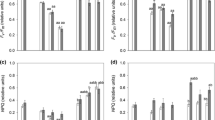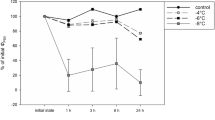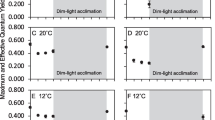Abstract
Freshwater green algae of the Haematococcus lacustris species complex are known for their ability to accumulate the secondary carotenoid astaxanthin, which has various industrial applications. Survival of H. lacustris in harsh environments is facilitated by the formation of desiccation-tolerant akinetes, which are thick-walled, resistant cells. In this study, we compared the desiccation tolerance of green and red akinetes and investigated the effect of different desiccation periods and extreme temperatures on their viability. We used the effective quantum yield of the photosystem II as an indicator of how akinetes respond to environmental stress. We also examined the ultrastructure of the akinetes using electron microscopy. Both green and red akinetes survived desiccation at all dehydration rates tested. The effective quantum yield of the green akinetes was generally higher than that of the red akinetes throughout the experiment. Moreover, desiccated red akinetes were able to survive different additional stresses, even exposure to extreme temperatures of − 80 °C and 55 °C. Red akinetes that had not been previously desiccated tolerated freezing better than high temperature. These findings contribute to our understanding of the desiccation tolerance of Haematococcus akinetes and have implications for the global distribution of this alga.





Similar content being viewed by others
References
Allewaert, C. C., P. Vanormelingen, T. Pröschold, P. I. Gómez, M. A. González, G. Bilcke, S. D’Hondt & W. Vyverman, 2015. Species diversity in European Haematococcus pluvialis (Chlorophyceae, Volvocales). Phycologia 54(6): 583–598. https://doi.org/10.2216/15-55.1.
Alpert, P., 2006. Constraints of tolerance: why are desiccation-tolerant organisms so small or rare? Journal of Experimental Biology 209(9): 1575–1584. https://doi.org/10.1242/jeb.02179.
Blokker, P., 2000. Structural analysis of resistant polymers in extant algae and ancient sediments, Vol. 193. Utrecht University, Utrecht.
Blokker, P., S. Schouten, H. van den Ende, J. W. de Leeuw, P. G. Hatcher & J. S. S. Damsté, 1998. Chemical structure of algaenans from the fresh water algae Tetraedron minimum, Scenedesmus communis and Pediastrum boryanum. Organic Geochemistry 29(5–7): 1453–1468. https://doi.org/10.1016/s0146-6380(98)00111-9.
Blokker, P., S. Schouten, J. W. de Leeuw, J. S. S. Damsté & H. van den Ende, 1999. Molecular structure of the resistant biopolymer in zygospore cell walls of Chlamydomonas monoica. Planta 207: 539–543. https://doi.org/10.1007/s004250050515.
Boussiba, S., 2000. Carotenogenesis in the green alga Haematococcus pluvialis: cellular physiology and stress response. Physiologia Plantarum 108(2): 111–117. https://doi.org/10.1034/j.1399-3054.2000.108002111.x.
Boussiba, S., W. Bing, J. P. Yuan, A. Zarka & F. Chen, 1999. Changes in pigments profile in the green alga Haematococcus pluvialis exposed to environmental stresses. Biotechnology Letters 21(7): 601–604. https://doi.org/10.1023/A:1005507514694.
Cellamare, M., M. Leitão, M. Coste, A. Dutartre & J. Haury, 2010. Tropical phytoplankton taxa in Aquitaine lakes (France). Hydrobiologia 639(1): 129–145. https://doi.org/10.1007/s10750-009-0029-x.
Chan, K. C., M. C. Mong & M. C. Yin, 2009. Antioxidative and anti-inflammatory neuroprotective effects of astaxanthin and canthaxanthin in nerve growth factor differentiated PC12 cells. Journal of Food Science 74(7): 225–231. https://doi.org/10.1111/j.1750-3841.2009.01274.x.
Chekanov, K., E. Lobakova, I. Selyakh, L. Semenova, R. Sidorov & A. Solovchenko, 2014. Accumulation of astaxanthin by a new Haematococcus pluvialis strain BM1 from the White Sea coastal rocks (Russia). Marine Drugs 12(8): 4504–4520. https://doi.org/10.3390/md12084504.
Collins, A. M., H. D. T. Jones, D. Han, Q. Hu, T. E. Beechem & J. A. Timlin, 2011. Carotenoid distribution in living cells of Haematococcus pluvialis (Chlorophyceae). PLoS ONE 6(9): e24302. https://doi.org/10.1371/journal.pone.0024302.
Del Río, E., F. G. Acién, M. C. García-Malea, J. Rivas, E. Molina-Grima & M. G. Guerrero, 2005. Efficient one-step production of astaxanthin by the microalga Haematococcus pluvialis in continuous culture. Biotechnology and Bioengineering 91(7): 808–815. https://doi.org/10.1002/bit.20547.
Demura, M., M. Ioki, M. Kawachi, N. Nakajima & M. M. Watanabe, 2014. Desiccation tolerance of Botryococcus braunii (Trebouxiophyceae, Chlorophyta) and extreme temperature tolerance of dehydrated cells. Journal of Applied Phycology 26(1): 49–53. https://doi.org/10.1007/s10811-013-0059-7.
Domínguez-Bocanegra, A. R., I. G. Legarreta, F. M. Jeronimo & A. Campocosio, 2004. Influence of environmental and nutritional factors in the production of astaxanthin from Haematococcus pluvialis. Bioresource Technology 92(2): 209–214. https://doi.org/10.1016/j.biortech.2003.04.001.
Droop, M. R., 1956. Haematococcus pluvialis and its allies. I. the Sphaerellaceae. Revue Algologique 2: 53–71.
Elliott, A. M., 1934. Morphology and life history of Haematococcus pluvialis. Archiv Für Protistenkunde 82: 250–272.
Figuerola, J. & A. J. Green, 2002. Dispersal of aquatic organisms by waterbirds: a review of past research and priorities for future studies. Freshwater Biology 47: 483–494. https://doi.org/10.1046/j.1365-2427.2002.00829.x.
Genitsaris, S., M. Moustaka-Gouni & K. A. Kormas, 2011. Airborne microeukaryote colonists in experimental water containers: diversity, succession, life histories and established food webs. Aquatic Microbial Ecology 62(2): 139–152. https://doi.org/10.3354/ame01463.
Genitsaris, S., K. A. Kormas, U. Christaki, S. Monchy & M. Moustaka-Gouni, 2014. Molecular diversity reveals previously undetected air-dispersed protist colonists in a Mediterranean area. Science of the Total Environment 478: 70–79. https://doi.org/10.1016/j.scitotenv.2014.01.071.
Genitsaris, S., N. Stefanidou, M. Katsiapi, E. Vardaka, K. A. Kormas, U. Sommer & M. Moustaka-Gouni, 2016. Haematococcus: a successful air-dispersed colonist in ephemeral waters is rarely found in phytoplankton communities. Turkish Journal of Botany 40(4): 427–438. https://doi.org/10.3906/bot-1509-8.
Gray, D. W., L. A. Lewis & Z. G. Cardon, 2007. Photosynthetic recovery following desiccation of desert green algae (Chlorophyta) and their aquatic relatives. Plant, Cell & Environment 30(10): 1240–1255. https://doi.org/10.1111/j.1365-3040.2007.01704.x.
Greenspan, L., 1977. Humidity fixed points of binary saturated aqueous solutions. Journal of Research of the National Bureau of Standards. Section A Physics and Chemistry 81(1): 89–96. https://doi.org/10.6028/jres.081a.011.
Gu, W., X. Xie, S. Gao, W. Zhou, G. Pan & G. Wang, 2013. Comparison of different cells of Haematococcus pluvialis reveals an extensive acclimation mechanism during its aging process: from a perspective of photosynthesis. PLoS ONE 8(6): e67028. https://doi.org/10.1371/journal.pone.0067028.
Gwak, Y., Y. S. Hwang, B. Wang, M. Kim, J. Jeong, C. G. Lee, Q. Hu, D. Han & E. Jin, 2014. Comparative analyses of lipidomes and transcriptomes reveal a concerted action of multiple defensive systems against photooxidative stress in Haematococcus pluvialis. Journal of Experimental Botany 65(15): 4317–4334. https://doi.org/10.1093/jxb/eru206.
Hagen, C., W. Braune & F. Greulich, 1993. Functional aspects of secondary carotenoids in Haematococcus lacustris [Girod] Rostafinski (Volvocales) IV. Protection from photodynamic damage. Journal of Photochemistry and Photobiology B: Biology 20(2–3): 153–160. https://doi.org/10.1016/1011-1344(93)80145-y.
Hagen, C., S. Siegmund & W. Braune, 2002. Ultrastructural and chemical changes in the cell wall of Haematococcus pluvialis (Volvocales, Chlorophyta) during aplanospore formation. European Journal of Phycology 37(2): 217–226. https://doi.org/10.1017/s0967026202003669.
Hata, N., J. C. Ogbonna, Y. Hasegawa, H. Taroda & H. Tanaka, 2001. Production of astaxanthin by Haematococcus pluvialis in a sequential heterotrophic-photoautotrophic culture. Journal of Applied Phycology 13(5): 395–402. https://doi.org/10.1023/A:1011921329568.
Hazen, T. E., 1899. The life history of Sphaerella lacustris. Memoirs of the Torrey Botanical Club 6: 211–244. https://doi.org/10.5962/bhl.title.97555.
Herburger, K., L. A. Lewis & A. Holzinger, 2015. Photosynthetic efficiency, desiccation tolerance and ultrastructure in two phylogenetically distinct strains of alpine Zygnema sp. (Zygnematophyceae, Streptophyta): role of pre-akinete formation. Protoplasma 252(2): 571–589. https://doi.org/10.1007/s00709-014-0703-3.
Hoham, R. W. & D. Remias, 2020. Snow and glacial algae: a review. Journal of Phycology 56(2): 264–282. https://doi.org/10.1111/jpy.12952.
Holzinger, A., M. C. Allen & D. D. Deheyn, 2016. Hyperspectral imaging of snow algae and green algae from aeroterrestrial habitats. Journal of Photochemistry and Photobiology B: Biology 162: 412–420. https://doi.org/10.1016/j.jphotobiol.2016.07.001.
Jyonouchi, H., S. Sun, K. Iijima & M. D. Gross, 2000. Antitumor activity of astaxanthin and its mode of action. Nutrition and Cancer 36(1): 59–65. https://doi.org/10.1207/s15327914nc3601_9.
Karsten, U., K. Herburger & A. Holzinger, 2014. Dehydration, temperature, and light tolerance in members of the aeroterrestrial green algal genus Interfilum (Streptophyta) from biogeographically different temperate soils. Journal of Phycology 50(5): 804–816. https://doi.org/10.1111/jpy.12210.
Kotak, S., J. Larkindale, U. Lee, P. von Koskull-Döring, E. Vierling & K. D. Scharf, 2007. Complexity of the heat stress response in plants. Current Opinion in Plant Biology 10(3): 310–316. https://doi.org/10.1016/j.pbi.2007.04.011.
Kuhl, A. & H. Lorenzen, 1964. Handling and culturing of Chlorella. In Methods in Cell Biology, Vol. 1. Academic Press, Cambridge, 159–187.
Lewis, L. A. & F. R. Trainor, 2012. Survival of Protosiphon botryoides (Chlorophyceae, Chlorophyta) from a Connecticut soil dried for 43 years. Phycologia 51(6): 662–665. https://doi.org/10.2216/11-108.1.
Lorenz, R. T. & G. R. Cysewski, 2000. Commercial potential for Haematococcus microalgae as a natural source of astaxanthin. Trends in Biotechnology 18(4): 160–167. https://doi.org/10.1016/s0167-7799(00)01433-5.
Lüttge, U. & B. Büdel, 2010. Resurrection kinetics of photosynthesis in desiccation-tolerant terrestrial green algae (Chlorophyta) on tree bark. Plant Biology 12(3): 437–444. https://doi.org/10.1111/j.1438-8677.2009.00249.x.
Montsant, A., A. Zarka & S. Boussiba, 2001. Presence of a nonhydrolyzable biopolymer in the cell wall of vegetative cells and astaxanthin-rich cysts of Haematococcus pluvialis (Chlorophyceae). Marine Biotechnology 3: 515–521. https://doi.org/10.1007/s1012601-0051-0.
Naguib, Y. M. A., 2000. Antioxidant activities of astaxanthin and related carotenoids. Journal of Agricultural and Food Chemistry 48(4): 1150–1154. https://doi.org/10.1021/jf991106k.
Nakada, T. & S. Ota, 2016. What is the correct name for the type of Haematococcus Flot (Volvocales, Chlorophyceae)? Taxon 65(2): 343–348.
Okai, Y. & K. Higashi-Okai, 1996. Possible immunomodulating activities of carotenoids in in vitro cell culture experiments. International Journal of Immunopharmacology 18(12): 753–758. https://doi.org/10.1016/s0192-0561(97)85558-0.
Park, J. S., B. D. Mathison, M. G. Hayek, J. Zhang, G. A. Reinhart & B. P. Chew, 2013. Astaxanthin modulates age-associated mitochondrial dysfunction in healthy dogs. Journal of Animal Science 91(1): 268–275. https://doi.org/10.2527/jas.2012-5341.
Park, J. C., S. P. Choi, M. E. Hong & S. J. Sim, 2014. Enhanced astaxanthin production from microalga, Haematococcus pluvialis by two-stage perfusion culture with stepwise light irradiation. Bioprocess and Biosystems Engineering 37: 2039–2047. https://doi.org/10.1007/s00449-014-1180-y.
Peebles, F., 1909. The life history of Sphaerella lacustris with special reference to the nature and behavior of the zoospores. Centralblatt Für Bacteriologie, Parasitenkunde Und Infektionskrankheiten 2(24): 511–521.
Permann, C., K. Herburger, M. Niedermeier, M. Felhofer, N. Gierlinger & A. Holzinger, 2021. Cell wall characteristics during sexual reproduction of Mougeotia sp. (Zygnematophyceae) revealed by electron microscopy, glycan microarrays and RAMAN spectroscopy. Protoplasma 258(6): 1261–1275. https://doi.org/10.1007/s00709-021-01659-5.
Permann, C., B. Becker & A. Holzinger, 2022. Temperature- and light stress adaptations in Zygnematophyceae: the challenges of a semi-terrestrial lifestyle. Frontiers in Plant Science 13: 945394. https://doi.org/10.3389/fpls.2022.945394.
Pichrtová, M., J. Kulichová & A. Holzinger, 2014. Nitrogen limitation and slow drying induce desiccation tolerance in conjugating green algae (Zygnematophyceae, Streptophyta) from polar habitats. PLoS ONE 9(11): e113137. https://doi.org/10.1371/journal.pone.0113137.
Pichrtová, M., E. Arc, W. Stöggl, I. Kranner, T. Hájek, H. Hackl & A. Holzinger, 2016. Formation of lipid bodies and changes in fatty acid composition upon pre-akinete formation in Arctic and Antarctic Zygnema (Zygnematophyceae, Streptophyta) strains. FEMS Microbiology Ecology 92: fiw096. https://doi.org/10.1093/femsec/fiw096.
Pocock, M. A., 1960. Haematococcus in Southern Africa. Transactions of the Royal Society of South Africa 36: 5–55. https://doi.org/10.1080/00359196009519031.
Proctor, V. W., 1957. Some controlling factors in the distribution of Haematococcus pluvialis. Ecology 38(3): 457–462. https://doi.org/10.2307/1929890.
Rascher, U., M. Liebig & U. Lüttge, 2000. Evaluation of instant lightresponse curves of chlorophyll fluorescence parameters obtained with a portable chlorophyll fluorometer on site in the field. Plant, Cell & Environment 23: 1397–1405. https://doi.org/10.1046/j.1365-3040.2000.00650.x.
Rippka, R. & M. Herdman, 1992. Pasteur culture collection of cyanobacterial strains in axenic culture. Catalogue and taxonomic handbook, catalogue of strains 1992/1993, 1: 1–103.
Roach, T., N. Böck, N. Rittmeier, E. Arc, I. Kranner & A. Holzinger, 2022a. Acquisition of desiccation tolerance in Haematococcus pluvialis requires photosynthesis and coincides with lipid and astaxanthin accumulation. Algal Research 64: 102699. https://doi.org/10.1016/j.algal.2022.102699.
Roach, T., A. Fambri & D. Ballesteros, 2022b. Humidity and light modulate oxygen-induced viability loss in dehydrated Haematococcus lacustris cells. Oxygen 2(4): 503–517. https://doi.org/10.3390/oxygen2040033.
Roháček, K. & M. Barták, 1999. Technique of the modulated chlorophyll fluorescence: basic concepts, useful parameters, and some applications. Photosynthetica 37(3): 339–363. https://doi.org/10.1023/a:1007172424619.
Saha, S. K., E. McHugh, J. Hayes, S. Moane, D. Walsh & P. Murray, 2013. Effect of various stress-regulatory factors on biomass and lipid production in microalga Haematococcus pluvialis. Bioresource Technology 128: 118–124. https://doi.org/10.1016/j.biortech.2012.10.049.
Santos, M. F. & J. F. Mesquita, 1984. Ultrastructural study of Haematococcus lacustris (Girod.) Rostafinski (Volvocales) I. Some aspects of carotenogenesis. Cytologia 49: 215–228. https://doi.org/10.1508/cytologia.49.215.
Sarada, R., U. Tripathi & G. Ravishankar, 2002. Influence of stress on astaxanthin production in Haematococcus pluvialis grown under different culture conditions. Process Biochemistry 37: 623–627. https://doi.org/10.1016/s0032-9592(01)00246-1.
Smirnoff, N., 1993. Tansley Review No. 52 the role of active oxygen in the response of plants to water deficit and desiccation. New Phytologist 125: 27–58. https://doi.org/10.1111/j.1469-8137.1993.tb03863.x.
Souffreau, C., P. Vanormelingen, E. Verleyen, K. Sabbe & W. Vyverman, 2010. Tolerance of benthic diatoms from temperate aquatic and terrestrial habitats to experimental desiccation and temperature stress. Phycologia 49(4): 309–324. https://doi.org/10.2216/09-30.1.
Spurr, A. S., 1969. A low viscosity epoxy resin embedding medium for electron microscopy. Journal of Ultrastructure Research 26: 31–43. https://doi.org/10.1016/s0022-5320(69)90033-1.
Tjahjono, A. E., Y. Hayama, T. Kakizono, Y. Terada, N. Nishio & S. Nagai, 1994. Hyper-accumulation of astaxanthin in a green alga Haematococcus pluvialis at elevated temperatures. Biotechnology Letters 16(2): 133–138. https://doi.org/10.1007/bf01021659.
Triki, A., P. Maillard & C. Gudin, 1997. Gametogenesis in Haematococcus pluvialis Flotow (Volvocales, Chlorophyta). Phycologia 36(3): 190–194. https://doi.org/10.2216/i0031-8884-36-3-190.1.
Wan, M., D. Hou, Y. Li, J. Fan, J. Huang, S. Liang, W. Wang, R. Pan, J. Wang & S. Li, 2014. The effective photoinduction of Haematococcus pluvialis for accumulating astaxanthin with attached cultivation. Bioresource Technology 163: 26–32. https://doi.org/10.1016/j.biortech.2014.04.017.
Wang, B., A. Zarka, A. Trebst & S. Boussiba, 2003. Astaxanthin accumulation in Haematococcus pluvialis (Chlorophyceae) as an active photoprotective process under high irradiance. Journal of Phycology 39(6): 1116–1124. https://doi.org/10.1111/j.0022-3646.2003.03-043.x.
Wayama, M., S. Ota, H. Matsuura, N. Nango, A. Hirata & S. Kawano, 2013. Three-dimensional ultrastructural study of oil and astaxanthin accumulation during encystment in the green alga Haematococcus pluvialis. PLoS ONE 8(1): e53618. https://doi.org/10.1371/journal.pone.0053618.
Zhang, W., J. Wang, J. Wang & T. Liu, 2014. Attached cultivation of Haematococcus pluvialis for astaxanthin production. Bioresource Technology 158: 329–335. https://doi.org/10.1016/j.biortech.2014.02.044.
Acknowledgements
This work was supported by the institutional grant of the Charles University, Prague "Cooperatio Biology", by Charles University Research Centre Program No. 204069 and by the Czech Science Foundation Project No. 22-20989S.
Funding
Funding was provided by Grantová Agentura České Republiky (22-20989S), Charles University Research Centre (204069), and Univerzita Karlova v Praze (Cooperatio).
Author information
Authors and Affiliations
Corresponding author
Ethics declarations
Conflict of interest
Conflict of interest The authors declare that they have no conflict of interest.
Additional information
Handling editor: Judit Padisak
Publisher's Note
Springer Nature remains neutral with regard to jurisdictional claims in published maps and institutional affiliations.
Supplementary Information
Below is the link to the electronic supplementary material.
Online resource 1
Representative microscopic images of the green and red akinetes used in this study (JPG 1501 kb)
Supplementary file1 (JPG 1501 KB)
Rights and permissions
Springer Nature or its licensor (e.g. a society or other partner) holds exclusive rights to this article under a publishing agreement with the author(s) or other rightsholder(s); author self-archiving of the accepted manuscript version of this article is solely governed by the terms of such publishing agreement and applicable law.
About this article
Cite this article
Vávrová, K., Nemcova, Y. & Pichrtová, M. Desiccation and temperature tolerance of green and red Haematococcus lacustris (Chlamydomonadales, Chlorophyta) akinetes. Hydrobiologia 851, 1169–1181 (2024). https://doi.org/10.1007/s10750-023-05381-6
Received:
Revised:
Accepted:
Published:
Issue Date:
DOI: https://doi.org/10.1007/s10750-023-05381-6




